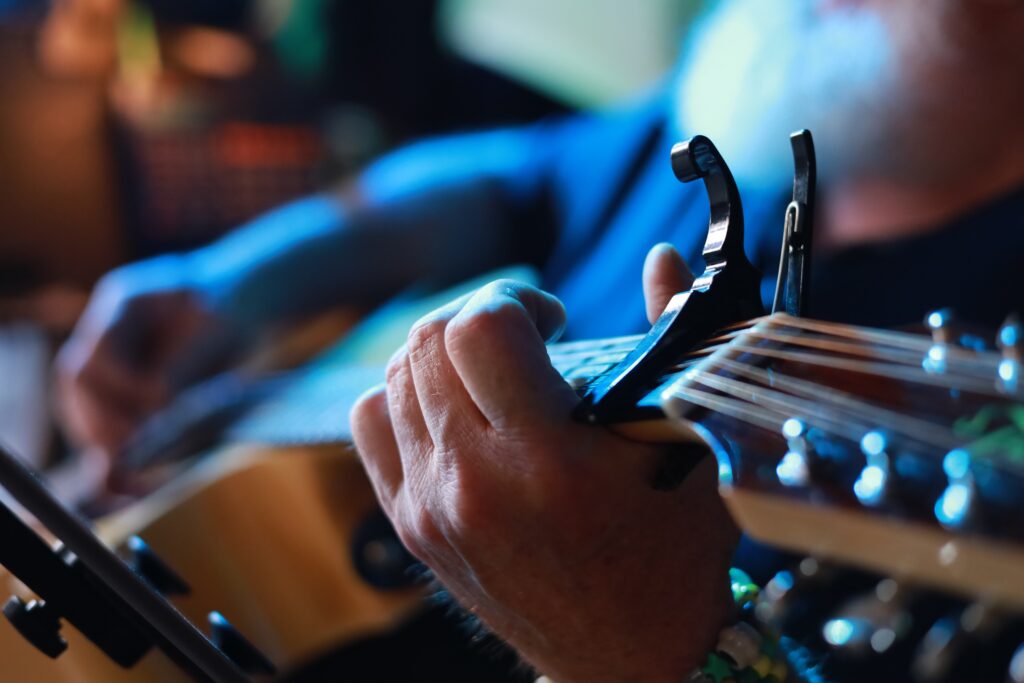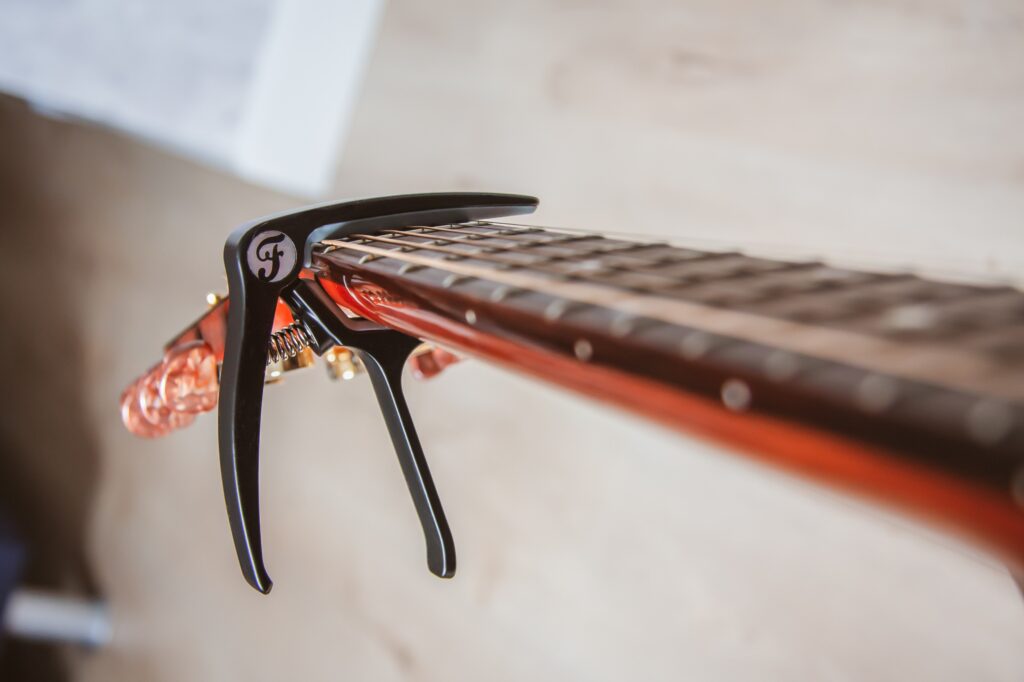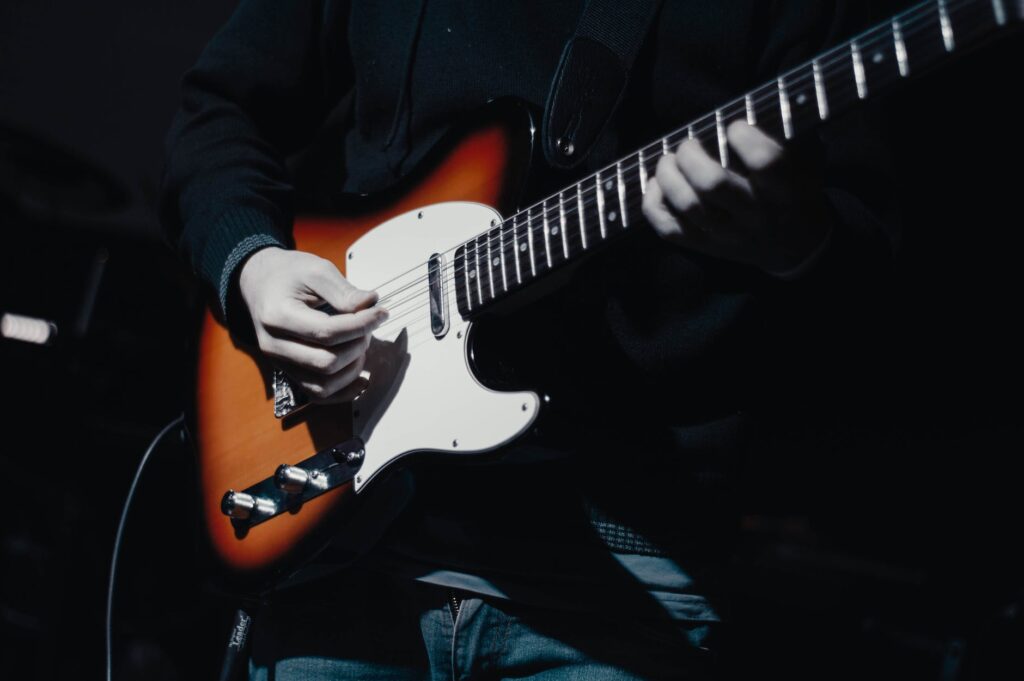
The Basics of a Guitar Capo
If you’ve ever wondered how to change the key of a song without learning new chords or using complicated fingerings, a guitar capo is your secret weapon. A guitar capo is a small device that clamps onto the neck of your guitar, effectively raising the pitch of the strings by shortening the playable length. In this article, we’ll dive into the world of guitar capos, exploring what they are, what they do, how to use them, and even delve into their fascinating history.
What Exactly is a Guitar Capo?
At its core, a capo is a simple tool that allows you to alter the pitch of your guitar without changing the fingerings of the chords you already know. It consists of a clamp that attaches to the neck of the guitar, exerting pressure on the strings and holding them down against the fretboard. By placing the capo on a specific fret, you effectively create a new “nut,” changing the starting point of the strings and raising the pitch of the open strings and any chords played.
The Purpose and Benefits of Using a Guitar Capo
Enhancing Your Playing with a Guitar Capo
Using a guitar capo opens up a world of possibilities and benefits for guitarists of all levels. Let’s explore some of the main advantages of incorporating a capo into your playing:
Transposing to Different Keys
One of the primary functions of a guitar capo is transposing songs to different keys. By placing the capo on a specific fret, you effectively shift the pitch of the guitar, allowing you to play familiar chord shapes in different keys. This is particularly useful when accompanying singers who may prefer a different key or when playing along with other instruments.
Expanding Your Vocal Range
For singers who accompany themselves on the guitar, a capo can be a game-changer. By using a capo, you can adjust the key of a song to match your vocal range, making it easier to hit high notes or sing comfortably within your desired range.
Creating Unique Sounds and Voicings
A guitar capo can also be a creative tool for exploring new sounds and voicings. By changing the starting point of the strings, you can achieve a brighter or mellower tone depending on the position of the capo. Additionally, using a capo in combination with different chord shapes can create unique voicings and chord progressions that add depth and variety to your playing.
How to Use a Guitar Capo

Getting Started with Your Guitar Capo
Using a capo may seem intimidating at first, but it’s actually quite simple. Follow these steps to get started:
Step 1: Choose the Right Capo
There are various types of guitar capos available, including spring-loaded capos, clamp-style capos, and partial capos. Experiment with different styles to find the one that feels most comfortable and secure on your guitar. Make sure the capo you choose is suitable for your guitar’s neck shape and width.
Step 2: Positioning the Capo
Decide on the desired key change or the fret you want to place the capo on. Position the capo just behind the chosen fret, making sure it presses down on all the strings evenly and firmly. Avoid placing the capo too close to the fret, as it can cause buzzing or muting of the strings.
Step 3: Tuning Your Guitar
After placing the capo on the desired fret, it’s important to retune your guitar. The capo alters the pitch of the open strings, so they need to be adjusted to ensure proper intonation. Use a tuner to tune each string, making any necessary adjustments to ensure they are in tune. This step is crucial for maintaining accurate pitch and a well-balanced sound.
Step 4: Play and Experiment
Now that your guitar is tuned with the capo in place, it’s time to start playing! Explore the new possibilities that the capo opens up. Try strumming familiar chord shapes in different positions to discover unique voicings and chord progressions. Experiment with different fret positions to find the one that suits the song or your desired sound. Get creative and let your musical intuition guide you.
A Brief History of Guitar Capos
Tracing the Origins
The concept of using a capo-like device on stringed instruments dates back centuries. In fact, evidence of similar devices can be found in ancient Greek and Roman musical instruments. However, the modern guitar capo as we know it today has a more recent history.
Early Developments
In the mid-19th century, during the rise of the classical guitar, players started experimenting with capo-like devices to facilitate key changes. These early capos were often rudimentary and improvised, consisting of makeshift materials such as pencils, rubber bands, or even pieces of wood. While functional, these early versions lacked the stability and convenience of today’s capos.
Evolution of the Modern Capo
The development of the modern guitar capo gained momentum in the 20th century with advancements in manufacturing and materials. Companies began producing purpose-built capos using sturdy metal components and innovative designs. These capos offered greater stability, ease of use, and a more consistent pressure on the strings.
Choosing the Best Guitar Capo for You
Finding Your Perfect Guitar Capo
With a wide range of guitar capos available on the market, choosing the right one can seem overwhelming. Consider the following factors to help you make an informed decision:
Capo Type
There are various types of capos, including spring-loaded capos, clamp-style capos, and partial capos. Each type offers different advantages and suitability for specific playing styles. Experiment with different types to find the one that best suits your preferences and playing needs.
Guitar Compatibility
Ensure that the capo you choose is compatible with your guitar. Consider the neck shape and width of your instrument to ensure a secure fit and even pressure across all the strings.
Build Quality and Durability
Opt for a capo made with quality materials that can withstand regular use and provide reliable performance. Look for features like padded surfaces to protect your guitar’s finish and adjustable tension for precise control.
Ease of Use
Choose a capo that is easy to position and adjust on the guitar. A capo that can be quickly and securely attached and removed without causing any damage or disrupting your playing is ideal.
Popular Guitar Capo Brands
Trusted Brands for Guitar Capos
While there are many reputable guitar capo brands on the market, here are a few that have gained popularity among musicians:
Kyser
Kyser is known for its innovative and reliable capos. Their quick-release design and durable construction make them a favorite among guitarists worldwide. Kyser capos come in a range of colors and styles to suit different tastes.
Shubb
Shubb capos are renowned for their precision and superior craftsmanship. Their adjustable tension system ensures even pressure and consistent performance. Shubb capos are favored by professional musicians for their reliability and excellent tone.
G7th
G7th capos are designed with advanced technology and unique features. Their patented Adaptive Radius Technology ensures a perfect fit on any guitar neck, providing optimal pressure and intonation. G7th capos are known for their sleek design and ease of use.
Dunlop
Dunlop offers a wide range of capos suitable for different playing styles and preferences. Known for their durability and affordability, Dunlop capos provide reliable performance and are a popular choice among guitarists.
Embrace the Versatility of a Guitar Capo
In conclusion, a guitar capo is a versatile tool that allows you to explore new sounds, transpose songs to different keys, and expand your playing possibilities. With a capo, you can effortlessly change the pitch of your guitar without having to learn new chord shapes or complex fingerings. Whether you’re playing an acoustic guitar or an electric guitar, a capo can open up a world of creativity and musical exploration.
So, unleash your guitar’s potential with a capo. Experiment with different positions, create unique chord voicings, and enjoy the freedom to play in various keys. Whether you’re a beginner or an experienced guitarist, a guitar capo is a valuable addition to your musical toolkit.

